Did Peter really go to Rome?
The New Testament never mentions that Peter travelled to Rome. He addresses his letters to God’s elect, exiles scattered throughout the provinces of Pontus, Galatia, Cappadocia, Asia and Bithynia (1 Peter 1:1). So, he may have travelled to these places. He went to Caesarea to tell the Roman centurion Cornelius about the Lord Jesus’ saving grace (Acts 10). But this is all that is said about Peter’s travels.
Some say Peter never went to Rome and supporting evidence is in the fact, that in his letter to the Roman church, Paul does not list Peter among the 25 names he sent greetings to.
Persecution in Jerusalem and the church is scattered
Just before Jesus returned to heaven, he gave instructions to His disciples which are recorded in Acts 1:8:
“But you will receive power when the Holy Spirit comes on you; and you will be my witnesses in Jerusalem, and in all Judea and Samaria, and to the ends of the earth.”
The church commenced with Peter preaching as three thousand were added to their number (Acts 2:41). And the Lord added to their number daily (Acts 2:47).
As the church grew, so did persecution from both the Jews and king Herod. Stephen was stoned to death while Paul watches approvingly (Acts 7). This incident caused the church to disperse. Accordingly, the center of Christianity moved from Jerusalem to Antioch. As well, Peter was almost killed when he and James were arrested. James was put to the sword and Peter was miraculously set free by an angel (Acts 12).
Evidence that Peter lived in Rome
There is much evidence supporting the contention that Mark wrote his gospel from listening to Peter preach and this was in Rome.
Early Christian apologist, Justin Martyr, wrote Dialogue with Trypho (approximately AD 150) and included this interesting passage:
It is said that he [Jesus] changed the name of one of the apostles to Peter; and it is written in his memoirs that he changed the names of others, two brothers, the sons of Zebedee, to Boanerges, which means ‘sons of thunder’….
Justin, therefore, identified a particular Gospel as the ‘memoir’ of Peter and said this memoir described the sons of Zebedee as the ‘sons of thunder’. Only Mark’s Gospel describes John and James in this way, so it is reasonable to assume that the Gospel of Mark is the memoir of Peter.
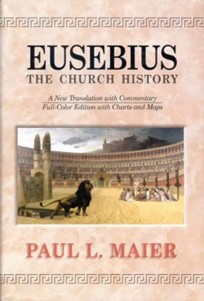 Eusebius (AD 260-339) was the bishop in Caesarea and was the first Christian historian. He covered the time from when the New Testament ended to the time of Constantine under whose direction Christianity became the state religion. As well, Eusebius was a confidant of Constantine.
Eusebius (AD 260-339) was the bishop in Caesarea and was the first Christian historian. He covered the time from when the New Testament ended to the time of Constantine under whose direction Christianity became the state religion. As well, Eusebius was a confidant of Constantine.
In his book, Eusebius The Church History, [1] Dr Paul L Maier presents a word for word translation of Eusebius’s Church History, he makes the following comment: It is most fortunate that Eusebius quotes his sources extensively, since many of them have been lost and would not have survived, even in fragments had Eusebius not incorporated them into his history.
In reference to Mark’s gospel, Eusebius writes: Peter’s hearers, not satisfied with a single hearing or with the unwritten teaching of the divine message, pleaded with Mark, whose gospel we have, to leave them a written summary of the teaching given them verbally, since he was a follower of Peter. Nor did they cease until they persuaded him and so called the Gospel according to Mark. It is said that the apostle was delighted at their enthusiasm and approved the reading of the book in the churches. Clement [Clement of Rome] quotes the story in Outlines, Book 6, and Bishop Papias of Hierapolis confirms it. He [Clement?] points out that Peter mentions Mark in his first epistle and that he composed this in Rome, which they say he himself indicates when referring to the city as Babylon, chosen together with you, sends you greetings so does my son Mark (1 Peter 5:13).[2]
Papias was a Greek Apostolic Father, Bishop of Hierapolis, and author who lived from about AD 60 – about 130. His writings have been lost. Eusebius records him as stating in relation to Mark being Peter’s interpreter:
Mark became Peter’s interpreter and wrote down accurately, but not in order, all that he remembered of the things said and done by the Lord. For he had not heard the Lord or been one of his followers, but later, as I said, a follower of Peter. Peter used to teach as the occasion demanded, without giving systematic arrangement to the Lord’s sayings, so that Mark did not err in writing down some things just as he recalled them. For he had one overriding purpose: to omit nothing that he had heard and to make no false statements on his account.[3]
Irenaeus of Lyons (AD 130-202) was a second-century Christian theologian and writer who wrote his Against Heresies, a refutation of Gnosticism and a defense of the four-fold gospel. He had seen and heard the preaching of Polycarp, who in turn was said to have heard John the Evangelist and thus was the last-known living connection with the Apostles. However, none of his works aside from Against Heresies and The Demonstration of the Apostolic Preaching survive today.
Eusebius quoted Irenaeus in a portion of Irenaeus’s Book 3, which he wrote in reference to Mark’s gospel, which confirmed Mark as being with Peter and he adds that they both were in Rome:
Matthew composed a written gospel for the Hebrews in their own language, while Peter and Paul were preaching the gospel in Rome and founding the church there. After their deaths, Mark too, the disciple and interpreter of Peter, handed on to us in writing the things proclaimed by Peter.
A word of correction, Peter and Paul did not start the church in Rome, it was already in existence when Paul arrived (Romans 1:8-11) which was after he had written his letter, “Romans.” The church may well have started by Jews returning to Rome after listing to Peter at Pentecost as recorded in Acts 2.
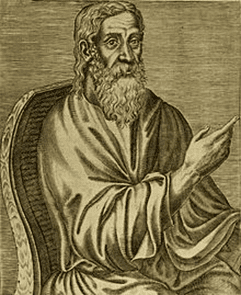 As well as the above, Eusebius quotes Clement of Alexandria (c.150-c.215) [image drawn in 1585] and claims that he, Eusebius, has all his major writings. Regarding Mark’s gospel which Clement included in his Outlines, Eusebius writes:
As well as the above, Eusebius quotes Clement of Alexandria (c.150-c.215) [image drawn in 1585] and claims that he, Eusebius, has all his major writings. Regarding Mark’s gospel which Clement included in his Outlines, Eusebius writes:
In the same books, Clement has included a tradition of the earliest elders regarding the order of the gospels, namely, that those with genealogies were written first and that Mark originated as follows. When, by the Spirit, Peter had publicly proclaimed the gospel in Rome, his many hearers urged Mark, as one who had followed him for years and remembered what was said, to put it all in writing. This he did and gave copies to all who asked. When Peter learned of it, he neither objected nor promoted it.[4]
Origen.[5]
Another early writer who Eusebius quotes regarding the genesis of Mark’s gospel is Origen. In his Commentary on Matthew, Origen writes, I learned by tradition that the four gospels alone are unquestionable in the church of God. First to be written was by Matthew, who was once a tax collector but later an apostle of Jesus Christ, who published in Hebrew for Jewish believers. The second was by Mark, who wrote it following Peter’s directives, whom Peter also acknowledged as his son in his epistle: “The church in Babylon greets you …. And so does my son Mark” (1 Peter5:13). The third is by Luke, who wrote the gospel praised by Paul for Gentile believers. After them all came John’s.[6]
Summary to date
So, Eusebius in his The Church History which he wrote in the early fourth century, quotes other earlier church historians going back to the late first, or early second century, all in agreement that Mark wrote his gospel when he was in Rome listening to Peter preach. He wrote it at the request of the people while Peter was still alive (Clement of Alexander).
Tertullian affirmed Peter’s influence on the Gospel of Mark
Early Christian theologian and apologist, Tertullian (AD 160-225), wrote a book that refuted the theology and authority of Marcion. The book was appropriately called, Against Marcion and in Book 4 Chapter 5, he described the Gospel of Mark:
While that [gospel] which Mark published may be affirmed to be Peter’s whose interpreter Mark was.
These early church writers are unanimous that Peter lived and preached in Rome.
Was Peter executed in Rome and was he buried there? What do early Christian writers say?
As early as AD 96, Clement, bishop of Rome not to be confused with Clement of Alexandra, wrote; ..who [Peter] because of unjust jealousy bore up under hardships not just one or twice but many times; and having thus borne his witness [martyresas] he went to the place of glory that he deserved and Paul, who because of jealousy and strife…. pointed the way to the prize for endurance…bearing his witness [martyresas] before the rulers.[7]
So, Clement of Rome states that both Peter and Paul were in Rome, and they were both executed there with the likely date being AD 64, the year Nero blamed Christians for starting the great fire in the city.
Eusebius writes concerning the death of Peter [8]
So it happened that this man [Nero], the first to announced publicly as a fighter against God, was led on to slaughter the apostles. It is related that in his reign Paul was beheaded in Rome itself and Peter was also crucified, and the cemeteries there still called by the names of Peter and Paul confirm the record. So does a churchman called by the name of Caius[9] (stylized drawing attached), who lived when Zephyrinus was bishop of Rome. In a written dialogue with Proclus, the leader 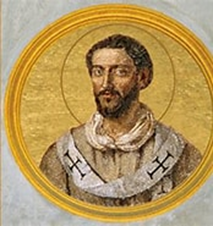 of the Phrygian opinion [the Montanists], Gaius says the following about the places where the sacred remains of the apostles in question are laid:
of the Phrygian opinion [the Montanists], Gaius says the following about the places where the sacred remains of the apostles in question are laid:
“I can point out the trophies [tropaion in Greek, trophies, monuments, graves] of the apostles. If you will go to the Vatican or the Ostian Way, you will find the trophies of those who founded this church.” Caius wrote about AD 200.
What makes Eusebius’ citation so powerful is that he is not providing an interpretation of what Caius wrote, but a direct quotation.
Summary to date
Early Christians writers confirm that both Peter and Paul lived in Rome and both were executed there. And that Peter’s grave in the Vatican and Paul’s is on the Ostian Way.
Vatican
Caius states that the apostle Peter’s grave is at the Vatican, so what is referred to as the Vatican?
The Vatican was the last of the fourteen administrative districts into which Rome was divided by Augustus. The name may have been derived from an early Etruscan settlement. The whole area, called the Ager (field or district) Vaticanus, was across from the Campus Martinuson the west side of the Tiber River and north of the Janiculum hill. The area was swampy and infested with snakes. The Romans considered this originally uninhabited part of Rome dismal and ominous.
During the Roman Empire, many villas were constructed there, after Agrippina the Elder (14 BC – 18 October AD 33) drained the area and laid out her gardens in the 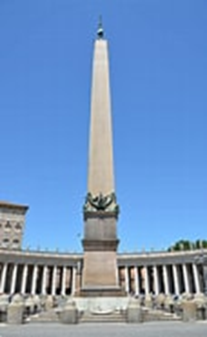 early 1st century AD. In AD 40, her son, Emperor Caligula (31 August AD 12 – 24 January AD 41) built in her gardens a circus for charioteers (AD 40) that was later completed by Nero, the Circus Gaii et Neronis, usually called, simply, the Circus of Nero.
early 1st century AD. In AD 40, her son, Emperor Caligula (31 August AD 12 – 24 January AD 41) built in her gardens a circus for charioteers (AD 40) that was later completed by Nero, the Circus Gaii et Neronis, usually called, simply, the Circus of Nero.
The Vatican obelisk in St. Peter’s Square (pictured) is the last visible remnant from the Circus of Nero. It was brought from Heliopolis in Egypt by Emperor Caligula. The obelisk originally stood at the centre of the spina (median) of the Roman circus. The circus became the site of martyrdom for many Christians after the Great Fire of Rome in AD 64. Tradition states that it was in this circus that Peter was crucified upside-down.
In 1586, the obelisk was relocated to its current position by Pope Sixtus V.
The search for Peter’s remains
Jack Finegan (1908-2000) writes[10]; In the period from approximately 130 to 300 a double row of magnificent mausolea were built over the pre-existing cemetery, thereby partly obliterating it.
Near the west end of the double row of mausolea was found a steep narrow street. On the east side of this street was a wall, the purpose of which was to fix the boundaries of the street and of adjacent tombs. Set into the east side of this wall, facing an open court, is a two-story niche or shrine (the “Aedicula”). The wall was plastered and colored red (and sometimes referred to as the “Red Wall”), and the Aedicula was constructed at the same time as the wall into which it is recessed, at about AD 160. Some early burials extend under the Red Wall, and there are traces of an ancient grave under the Aedicula. On the Red Wall and probably not much later than the wall and the Aedicula, a graffito was found with the name of Peter and a word possibly meaning “is within”, thus a scratched notation by some worker or visitor that “Peter is buried inside”. Accordingly, the Aedicula probably marked the last resting place of Peter, and this shrine may therefore be recognized, as is done by most scholars, as the “trophy” or tomb of Peter at the Vatican to which Gaius made reference around AD 200.
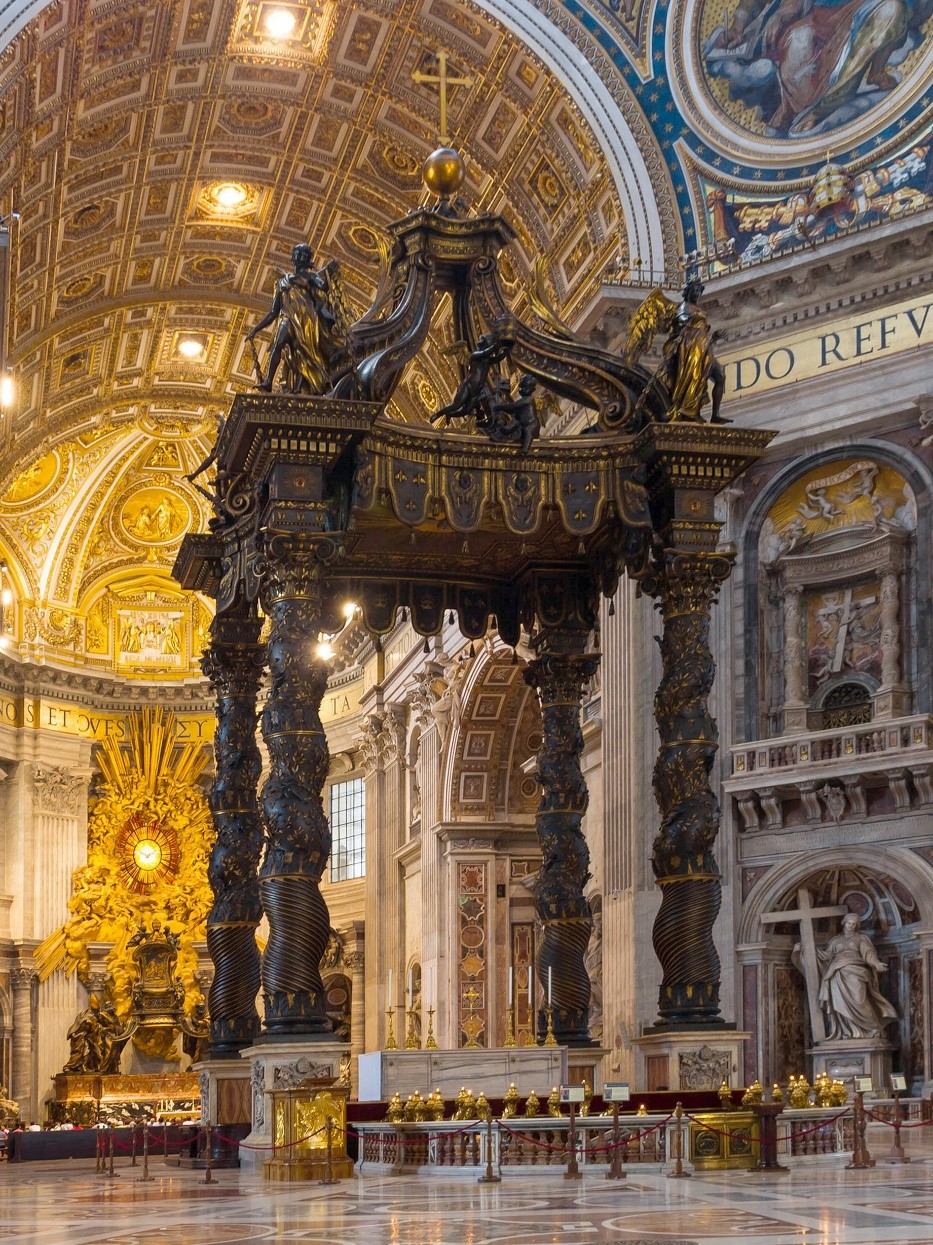 At the exact place believed to have this significance the emperor Constantine built a large church (or mausoleum, or Basilica). To put the church exactly here involved a project of extraordinary difficulty because of the pre-existing cemetery. This cemetery had to be invaded (surely a moral if not also a legal problem) and a large building area leveled (involving the moving of an estimated more than million cubic feet of earth). In most cases the roofs of the mausolea were removed, earth was packed into the exposed chambers, and the foundation walls of the church were set into the midst of the cemetery. Obviously, Constantine could have chosen an easier site if his purpose was anything other than to build a church over what he believed to be the tomb of Peter.[11]
At the exact place believed to have this significance the emperor Constantine built a large church (or mausoleum, or Basilica). To put the church exactly here involved a project of extraordinary difficulty because of the pre-existing cemetery. This cemetery had to be invaded (surely a moral if not also a legal problem) and a large building area leveled (involving the moving of an estimated more than million cubic feet of earth). In most cases the roofs of the mausolea were removed, earth was packed into the exposed chambers, and the foundation walls of the church were set into the midst of the cemetery. Obviously, Constantine could have chosen an easier site if his purpose was anything other than to build a church over what he believed to be the tomb of Peter.[11]
In the fifteenth century it was decided to demolish the Constantinian basilica because of its dilapidated condition, and in the sixteenth and seventeenth centuries it was replaced by the present church, designed by Bramante. The first stone was laid in 1506, the work was continued by Raphael in 1514, and the great dome made by Michelangelo in 1546. The church was dedicated in 1626. Bernini designed the bronze canopy over the altar in 1633 and later designed the colonnades around the elliptical piazza to which the obelisk had been moved in 1586. Six of the spiral columns which Constantine put above Peter’s tomb survive and were placed by Bernini in galleries in the dome of the present church. Under the present altar, which is the work of Clement VIII (1592–1605), are the altars of Callistus II (1119–1124) and Gregory the Great (590–604) and, beneath them all, in direct line, are the Red Wall and the Aedicula, the “trophy” of Peter.
Modern excavation
The following information is courtesy of Wikipaedia, https://en.wikipedia.org/wiki/Saint_Peter%27s_tomb.
A tomb had been discovered at the beginning of the 16th century, when the foundations were being laid for the four twisted columns of Gian Lorenzo Bernini’s. Construction of Constantine’s Old St. Peter’s Basilica and of foundations for Bernini’s Baldacchino destroyed most of the vaulting of these semi-subterranean burial chambers.
The burial chambers were uncovered again in 1939 as workmen dug a tomb for Pope Pius XI. Over the next ten years, Ludwig Kaas oversaw an archaeological excavation of the pagan mausoleum complex under the foundations of St. Peter’s Basilica (the Vatican Necropolis), dating to the 2nd and 3rd centuries. No mausoleum had ever been built directly beneath the present high altar of St Peter’s, which did however contain shallow burials, one dated by an impressed tile to the reign of Vespasian; subsequently they had been attended with care, as later burials clustered round but did not encroach upon the space. There was a small niched monument built into a wall ca. AD 160. The discoveries made the pages of Life magazine.
In 1942, the Administrator of St. Peter’s, Ludwig Kaas, found remains in a second tomb in the monument. Being concerned that these presumed relics of a saint would not be accorded with the respect they deserved, and having little understanding of correct archeological procedures, he secretly ordered these remains stored elsewhere for safekeeping.
After Kaas’s death, Margherita Guarducci discovered these relics by chance. She informed Pope Paul VI of her belief that these remains were those of Saint Peter. The anthropological tests on the relics fragmented was done by Professor Venerando Correnti of Palermo University in 1962, the results suggested that the bone fragments belong to a man who was a 60–70 years old and of robust physique. The examinations suggested that the feet of the person were viciously cut as Romans did to crucified corpses because it was easier than removing nails.
On June 26, 1968, Pope Paul VI announced that the relics of Saint Peter had been discovered, though only circumstantial evidence supports this claim.
Summary
Both Caius and Eusebius claimed to be able to show anyone the graves/tombs of both Peter and Paul, Caius in AD 200. The area where Peter was buried was a common burial site in the Provence called the Vatican. Constantine constructed a mausoleum (basilica) over the tomb of Peter. But in doing so, he had to reshape the topography of the area significantly. In the fifteenth century it was decided to demolish the Constantinian basilica because of its dilapidated condition, and in the sixteenth and seventeenth centuries it was replaced by the present church with its large bronze altar over what is thought to be Peter’s tomb. Modern archaeology has given some credence to this.
[1] Dr Paul L Maier, Eusebius The Church History, Kregel Publications, 1999.
[2] Ibid page 73.
[3] Ibid page 129-130.
[4] Ibid page 218.
[5] Origen of Alexandria (c. 185 – c. 253), also known as Origen Adamantius, was an early Christian scholar, ascetic, and theologian who was born and spent the first half of his career in Alexandria. Origen was able to produce a massive quantity of writings because of the patronage of his close friend Ambrose of Alexandria, who provided him with a team of secretaries to copy his works, making him one of the most prolific writers in all of antiquity.
[6] Maier, page 226.
[7] 1 Clement 5:4-7; cited by David Christian Clausen, https://davidchristianclausen.com.
[8] Ibid, pages 85-86.
[9] Caius, Presbyter of Rome (also known as Gaius) was a Christian author who lived and wrote towards the beginning of the 3rd century. Only fragments of his works are known, which are given in the collection entitled The Ante-Nicene Fathers.
[10] Biblical Archaeological Review, December 1976.
[11] Finnigan, The Death and Burial of St Peter. https://library.biblicalarchaeology.org/article/the-death-and-burial-of-st-peter.

